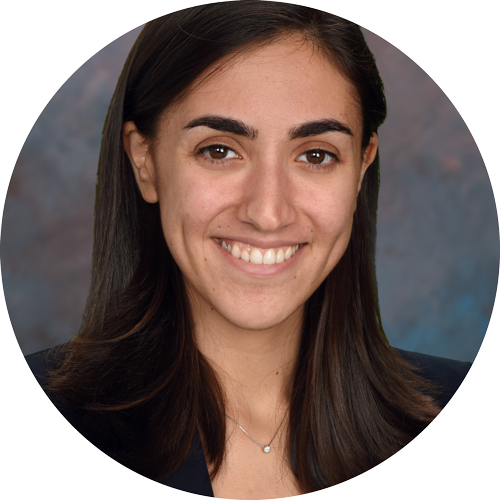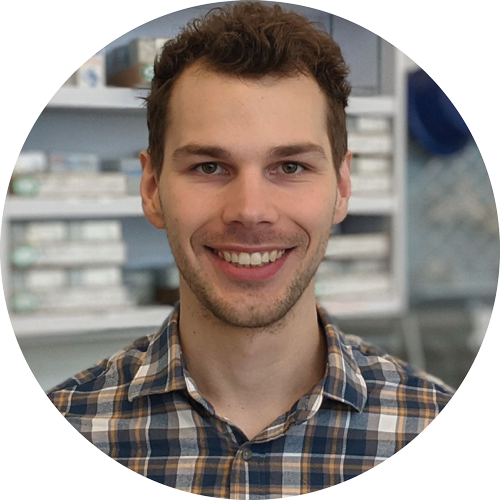
-
Careers • News • Contact us •
- Login
- Français
Events to come
May 05, 2022
From 9 AM to 7 PM
Location
110, Avenue des PinsMontréal, H2W 1R7
Conference
Early-Career Scientist Symposium

In October 2021, the IRCM launched its Early-Career Scientists Seminar Series, a new initiative whose mission is to showcase the best scientists in training from around the world. Out of the 150 young scientists of exceptional calibre who applied to this prestigious program, nine (9) senior PhD students were invited to present their fascinating projects and innovative ideas during this symposium. The IRCM is proud to support the next generation of scientists - join us as we showcase, together, the excellent research performed in academia.
This event is open to everyone. Registration is mandatory.
Hybrid event
To attend in person:
Auditorium and IRCM hall
110, avenue des Pins O, H2W 1R7 Montreal
Wearing a mask is mandatory at all times
Register for the online event (on Zoom)
These conferences are set to occur under a hybrid format. However, please note that last-minute changes to online-only lectures may occur due to unforeseen circumstances. We invite you to visit this webpage again a few days before attending.
Program
9:00 - 9:10 Dr. Michel Cayouette, VP - Research and Academic Affairs
9:10 - 9:50 Olimpia Bompadre, Université de Genève - The regulatory, transcriptional and phenotypical costs of non-coding mutations at the Pitx1 locus
9:50 - 10:30 Kevin Ng, Francis Crick Institute - Antibody responses in infection and cancer
10:30 - 11:00 Coffee break, Hall
11:00 - 11:40 Elisa Nerli, Max Planck Institute for Molecular Cell Biology and Genetics, Instituto Gulbenkian de Ciência - From progenitors to neurons: unveiling new principles of fate decisions in the vertebrate retina
11:40 - 12:20 Sébastien Lévesque, Laval University Medical Research Centre – Laval University - Marker-free coselection for successive rounds of prime editing in human cells
12:20 - 13:20 Lunch, Hall
13:20 - 14:00 Costanza Lo Cascio, Barrow Neurological Institute, Arizona State University - In pursuit of specificity: therapeutic targeting of HDAC1 in glioblastoma
14:00 - 14:40 Cameron Herberts, Vancouver Prostate Centre, University of British Columbia - Clonal architecture and evolution of treatment-resistant prostate cancer via deep whole-genome ctDNA sequencing
14:40 - 15:20 Rachel Wilson, Western University - Investigating the role of eukaryotic elongation factor 1A1 in non-alcoholic fatty liver disease and lipid metabolism
15:20 - 15:40 Coffee break, Hall
15:40 - 16:20 Tomás Pachano, University of Cantabria - Orphan CpG islands dictate the compatibility between poised enhancers and their target genes
16:20 - 17:00 Tianyuan Lu, Lady Davis Institute for Medical Research, McGill University - Genetic risk scores for complex diseases: new opportunities for clinical use
17:00 - 19:00 Happy Hour, Hall
Detailed program

Olimpia Bompadre
PhD candidate
(Lab: Dr. Guillaume Andrey)
Genetic Medicine and Development
University of Geneva, Switzerland
The regulatory, transcriptional and phenotypical costs of non-coding mutations at the Pitx1 locus
Advances in medical genetics have shown that structural variants can locally affect several features of chromatin, including 3D architecture, epigenetic modifications and gene transcription. Thus, it is difficult to decipher which one primarily accounts for gene misregulation. Using single-cell transcriptomics coupled with a novel in-embryo cell tracing approach on the Pitx1 testbed locus, we aim to understand the sequence of events leading to Pitx1 misregulation in different gain- and loss-of-function structural variants. Pitx1 expression in developing hindlimbs normally relies on the ability of its promoter to contact its fore- and hindlimb enhancer Pen in the 3D space of the nucleus, whereas Pen is sequestered from Pitx1 in transcriptionally inactive forelimbs. Here, we first show that the loss of the Pen enhancer affects Pitx1 expression in specific hindlimb cell populations by disabling the coordination between locus activity and 3D chromatin folding. Although this data suggests that enhancer-promoter are necessary for transcription, we found that the loss of Polycomb repression is sufficient to drive Pitx1 expression in forelimbs despite the absence of such contacts. We therefore believe that chromatin interactions could act upstream, to remove promoter-associated Polycomb repressive marks, enabling local cis-regulatory cues to activate transcription. In agreement with this hypothesis, we found that Pitx1-Pen ectopic contacts in forelimbs can induce Pitx1 expression in a fraction of limb cells that establish an epigenetically and structurally active locus. Therefore, we propose that 3D structure dynamics have a primary role to enable the release of repression and thus transcriptional onset at the Pitx1 locus.

Kevin Ng
PhD candidate
(Lab: Dr. George Kassiotis)
Biomedical Sciences
Francis Crick Institute, United Kingdom
Antibody responses in infection and cancer
B cells constitute a major part of the lung tumour microenvironment, where they are organized in tertiary lymphoid structures (TLS) that resemble antibody-producing germinal centres. The presence of TLS has been associated with response to immunotherapy, though the mechanisms behind this association remains unclear. Using a novel immunogenic mouse model of lung adenocarcinoma, we use lineage tracing mouse models and 3D immunofluorescence of optically cleared lungs to describe the evolution of lung germinal centre responses during tumour progression. We find that TLS organization is triggered by fibroblast-derived CXCL13 and that exogenous CXCL13 treatment increases B cell infiltration and overall survival. Using serum transfer experiments, we demonstrate that tumour-binding class-switched antibodies play an anti-tumour role and increase survival. We find that checkpoint blockade increases germinal centre B cell responses and antibody titres, and increases antibody functionality in vitro and in vivo. Using single-cell BCR sequencing of checkpoint blockade-treated mice, we show clonal expansion of tumour-binding antibodies reactive to re-expressed endogenous retroviral antigens. We find that endogenous retrovirus-specific antibodies are increased upon checkpoint blockade, therapeutic treatment with an endogenous retrovirus-specific monoclonal antibody increases tumour survival, and antibodies to human endogenous retroviruses can be detected in lung cancer patients. Finally, we demonstrate that treatment with a KRAS G12C inhibitor boosts B cell and antibody responses, and that these responses are compromised with MEK inhibition. Our work describes a novel role for B cells in the lung tumour microenvironment and show the therapeutic potential for selective boosting of anti-tumour B cell functions.

Elisa Nerli
PhD candidate
(Lab: Dr. Caren Norden)
Neuroscience
Max Planck Institute for Molecular Cell Biology and Genetics, Germany
Gulbenkian Science Institute, Portugal
From progenitors to neurons: unveiling new principles of fate decisions in the vertebrate retina
During central nervous system development, multipotent progenitors need to commit to different neuronal fates in a controlled manner. This ensures that the correct neurons arise in the right numbers, proportions and with the correct timing. If this process is compromised, impairments in neuronal connectivity and organ hypoplasia can occur, with severe functional consequences. Therefore, understanding what fate decisions progenitors undergo over time, the degree of plasticity of these decisions and how this plasticity is achieved is of utmost importance to understand nervous system assembly.
Previous studies in the vertebrate retina demonstrated that retinal progenitors are multipotent. However, there is still debate regarding whether and to what degree progenitors’ competence – what neurons progenitors can generate at distinct developmental times – changes during development and whether different fates arise through deterministic or probabilistic processes.
To assess the journey from progenitor to neuron, I take advantage of the developing zebrafish retina that hosts 6 major neuronal types. By following the progenitors’ lineages that produce these neurons, I investigated the plasticity of progenitor’s competence both in normal and in genetically perturbed conditions. My studies revealed that within the same lineage, deterministic and probabilistic fate decisions can occur. Interference with the probabilities of different fates results in a high degree of plasticity of the lineage. Combining these experiments with stochastic modelling, we describe a GRN that recapitulates the changes in progenitors’ competence, explaining how fate decisions plasticity underlies the robust production of the different neuronal types at the right time in development.

Sébastien Lévesque
PhD candidate
(Lab: Dr. Yannick Doyon)
Molecular Medicine
Laval University Medical Research Centre, Canada
Marker-free coselection for successive rounds of prime editing in human cells
Prime editing enables the introduction of precise point mutations, small insertions, or short deletions without requiring donor DNA templates. However, editing efficiency remains a key challenge in a broad range of cell types. We designed a robust coselection strategy to perform successive rounds of genetic changes in human cells using prime editors (PE). Through coediting, the recovery of cells modified at a target gene of interest is coupled to selection for dominant alleles of the ubiquitous and essential sodium/potassium pump (Na+/K+ ATPase) encoded by ATP1A1. The method improves prime editing efficiency 1.5–10-fold in K562, HeLa, and U2OS cells, reaching up to 83% of desired alleles in cell populations, for previously optimized prime editing guide RNAs (pegRNAs).
Using pegRNAs designed de novo, we readily engineered homozygous cell lines with cancer-associated and/or drug-resistant MTOR mutations displaying altered mTORC1 activity. In single cell-derived clones, we identified and characterized large PE-mediated insertions composed of repeated sequences formed by consecutive rounds of repair and nicking that could reach up to 1 kb. To further characterize these unwanted events, we adapted an EBFP to EGFP reporter system to assess the impact of nick sgRNA positions on tandem duplications between nick sites. Despite the decrease in product purity observed in the cell population, using a secondary nick (PE3) drastically increases multiallelic editing in individual cells. Our approach streamlines the production of cell lines with multiple genetic modifications to create cellular models for biological research.

Costanza Lo Cascio
PhD candidate
(Lab: Dr. Shwetal Mehta)
Neuroscience
Barrow Neurological Institute – Arizona State University, USA
In pursuit of specificity: therapeutic targeting of HDAC1 in glioblastoma
Glioblastoma (GBM), the most common and aggressive primary brain tumor affecting adults, is characterized by an aberrant yet druggable epigenetic landscape. Histone deacetylases (HDACs) mediate chromatin compaction and are frequently overexpressed in human cancers, including GBM. Hence, over the last decade, there has been considerable interest in HDAC inhibitors (HDACi) in the field of oncology. However, HDACi currently in clinical trials lack selectivity for individual HDAC isoforms and have failed to provide therapeutic benefit in patients. Not all HDACs are equally expressed in GBM, and the specific roles of individual HDAC isoforms in these tumors are not well understood. During my PhD, I dissected the functional importance of HDAC1 in GBM cancer stem cells, an HDAC isoform whose expression increases with brain tumor grade and is correlated with decreased survival. I discovered that HDAC1 is the essential HDAC in glioma stem cells, and its loss is not compensated for by its paralogue HDAC2 or other HDACs. Using cell-based biochemical assays and transcriptomic analyses, I demonstrated that loss of HDAC1 alone significantly attenuates the tumorigenic potential of glioma stem cells. Based on these findings I assessed the efficacy and pharmacokinetic properties of Quisinostat, a novel HDACi that has high specificity for HDAC1, in preclinical models of GBM. I found that Quisinostat not only reduces tumor burden, but also further sensitizes tumors to radiation treatment and significantly extends survival in patient-derived xenograft models of GBM. My studies therefore provide a rationale for the development of isoform-specific HDACi for the treatment of GBM.

Cameron Herberts
PhD candidate
(Lab: Dr. Alexander Wyatt)
Cancer Genomics and Bioinformatics
Vancouver Prostate Centre – University of British Columbia, Canada
Clonal architecture and evolution of treatment-resistant prostate cancer via deep whole-genome ctDNA sequencing
Liquid biopsy – especially circulating tumor DNA (ctDNA) – is changing the practice of oncology. In advanced cancers, ctDNA profiling can identify treatment-predictive biomarkers and is currently under evaluation in numerous clinical trials around the world. However, integration of ctDNA tests into clinical management is impeded by the poor understanding of the distinct tumor populations represented in ctDNA. Due to prior emphasis on targeted or low-resolution profiling approaches, we have an incomplete understanding of the somatic populations comprising bulk ctDNA.
To address this, we have performed deep whole-genome sequencing of serial plasma and synchronous metastases in a live clinical cohort of 33 prostate cancer patients treated with standard of care drugs—integrated with metastatic tissue whole-transcriptome sequencing. We comprehensively assess all classes of genomic alterations and demonstrate that ctDNA harbors multiple dominant populations whose evolutionary histories frequently indicate whole-genome doubling and shifts in mutational processes. Although tissue and ctDNA showed concordant clonally-expanded cancer driver alterations, each individual metastasis contributed only a minor share of total ctDNA. By comparing serial ctDNA before and after clinical progression on potent androgen receptor (AR) pathway inhibitors, we reveal population restructuring converging solely on AR augmentation as the dominant genomic driver of acquired treatment-resistance. Finally, we leverage nucleosome footprints in ctDNA to infer mRNA abundance in synchronously biopsied metastases, including treatment-induced changes in AR pathway transcriptional activity. Our results provide deep insights into cancer biology and position liquid biopsy as a comprehensive multi-omic discovery tool for cancers with high ctDNA fractions.

Rachel Wilson
PhD candidate
(Lab: Dr. Nica Borradaile)
Physiology and Pharmacology
Western University, Canada
Investigating the role of eukaryotic elongation factor 1A1 in non-alcoholic fatty liver disease and lipid metabolism
Non-alcoholic fatty liver disease (NAFLD) is thought to affect one quarter of the global population. Hepatocyte lipid accumulation, the defining characteristic of NAFLD, can progress to hepatocyte injury and inflammation, which increases risk for further disease progression to liver fibrosis and cirrhosis. Currently, the primary intervention for NAFLD patients is lifestyle modification, as there are no approved pharmacological therapies to specifically treat NAFLD. Previous work identified eukaryotic elongation factor 1A1 (EEF1A1) as a mediator of fatty acid-induced cell death (lipotoxicity). Canonically, EEF1A1 is involved in protein synthesis, but it also has moonlighting functions in regulating the actin cytoskeleton, protein folding and degradation, and viral pathogenesis. Given the role of lipotoxicity in the progression from hepatocyte lipid accumulation to hepatocyte injury and inflammation, we sought to investigate EEF1A1 as a target in NAFLD progression. In this seminar, I will describe our work targeting EEF1A1 by chemical and genetic modulation in the setting of NAFLD. We have been using didemnin B, a marine compound and chemical inhibitor of EEF1A1 peptide elongation activity, in a diet-induced obese mouse model and in cell culture models. We have also been utilizing a mutant EEF1A1-deficient Chinese hamster ovary cell line to investigate the roles of EEF1A1 in regulating lipid metabolism and cytoskeleton-dependent cell behaviour, the latter of which may have implications for limiting liver fibrosis in late-stage NAFLD.

Tomás Pachano
PhD candidate
(Lab: Dr. Alvaro Rada-Iglesias)
Developmental Genomics
University of Cantabaria, Spain
Orphan CpG islands dictate the compatibility between poised enhancers and their target genes
The establishment of cell type specific gene expression programs during vertebrate development is largely dependent on distal cis-regulatory sequences known as enhancers. An important question in enhancer biology is to understand how activating regulatory cues from enhancers are communicated specifically to their correct target gene and not others. It is widely assume that insulator elements can regulate enhancer specificity by restricting their search space to regions located within their same topological associated domain (TAD). However, recent evidences have identified examples in which genes do not respond to enhancers placed into their same TAD. Therefore, we hypothesize that genetic and/or biochemical compatibilities must further regulate how promoters respond to enhancers. Here, we uncover a novel role for CpG islands (CGIs) in dictating the compatibility between genes and distal enhancers. By using a CRISPR/Cas9 knock-in strategy, we inserted poised enhancers (PEs) within topological associated domains (TADs) containing genes with different promoter types. Analysis of the resulting cell lines revealed that developmental genes with CGI-rich promoters are particularly responsive to PEs, and that such responsiveness depends on the presence of an orphan CGI in proximity to the PE sequence. We report here that CGIs can amplify the regulatory activity of PEs by conferring them a permissive topological configuration that increases the responsiveness of target genes with CGI-associated promoters. Our results provide major insights into fundamental and unresolved questions of cisregulatory control during cell differentiation including: (i) the genetic factors controlling the topological features of enhancers; (ii) the regulatory rules dictating the compatibility and responsiveness between genes and enhancers. Moreover, our data will help to understand the pathomechanisms of human congenital diseases involving structural variants.

Tianyuan Lu
PhD candidate
(Labs: Dr. Brent Richards and Dr. Celia Greenwood)
Genetic Epidemiology
Lady Davis Institute for Medical Research – McGill University
Genetic risk scores for complex diseases: new opportunities for clinical use
Recent advances in human genetics, such as large-scale population-based cohorts and the application of statistical and machine learning approaches, have enabled development of polygenic risk scores for complex diseases. Though polygenic risk scores have been able to capture a substantial proportion of disease heritability, their clinical utility has not been fully explored. In the proposed talk, I will cover two perspectives of my research focused on exploiting polygenic risk scores for large populations:
- Developing polygenic risk scores as an effective risk prediction and stratification tool. I will showcase polygenic risk scores constructed in my work using various state-of-the-art methods. I will also illustrate the value of adding these scores to existing clinical risk factor-based risk prediction schemes for complex diseases, exemplified by cardiovascular diseases, osteoporotic fracture, and idiopathic short stature.
- Developing polygenic risk scores as an indication for prioritizing patients to undergo screening for rare pathogenic variants. Because polygenic risk and rare genetic causes, to a large extent, independently and additively contribute towards disease pathogenesis, affected patients with a low polygenic risk score may be more likely to carry rare pathogenic variants. I will illustrate this principle established in my work and its clinical utility in assisting diagnosis. Furthermore, I will introduce a novel method to combine polygenic risk score, family disease history and other clinical risk factors for improved decision-making in risk screening programs.

© Montreal Clinical Research Institute, Année.All rights reserves. | Privacy policy | Terms of use | Web site by Agence Riposte


